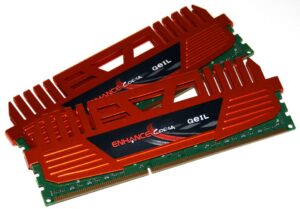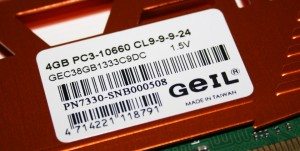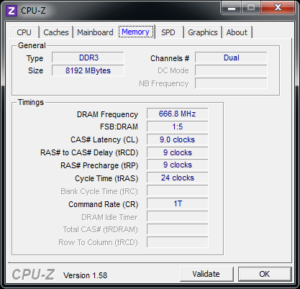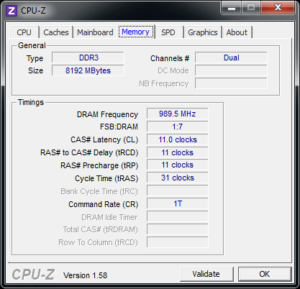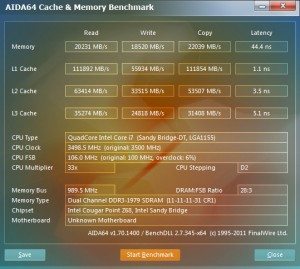GeIL Enhance Corsa DDR3 1333MHz 8GB Memory Kit Review
Andy Ruffell / 13 years ago
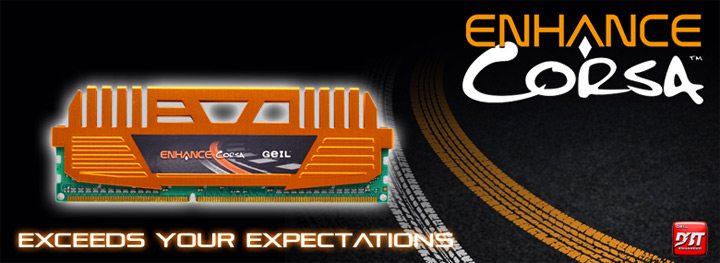
GeIL have been attempting to bring their branding and their name back into the market, with extreme efforts being focussed on in the UK. They have done so with a new range of memory products with the “Corsa” branding of which we’ve already looked at the 2133MHz Evo Corsa 8GB kit a little while ago, but for a lot of consumers, 2133MHz is still overkill.
GeIL have this in mind and have released another load of 8GB kits ranging in speed with the Enhance Corsa range with the 1333MHz kit being a prime example of offering the capacity that’s needed but with the mainstream user in careful consideration.
Even though it’s set to run at 1333MHz, the 1333MH and 1600MHz kits have been fully tested at higher speeds with the same CAS latency, which is all part of the unique selling point of the Enhance range.
The kit consists of two modules that include the EVO style heatspreaders which are raised above the PCB and could cause complications with some CPU coolers. The heatspreaders this time are bright orange and could match up quite nicely with the X58-OC board from Gigabyte if it used dual channel memory.
Each module is 4GB in capacity and runs at a slightly lower than average 1333MHz with timings of 9-9-9-24 at 1.5V. GeIL also make it clear that this set of modules has been tested at 1500MHz at CAS 9 which straight away shows some headroom and with a low voltage of 1.5V we can only hope that we can push it a little bit further.
Test system:
- Asus Maximus IV Extreme-Z
- Intel Core i7 2700k
- Gigabyte GeForce GTX 580 SOC
- Corsair H80
- Corsahir HX1050W
- Kingston V+100 128GB SSD
- Lian Li T60
When we booted into BIOS to make sure all of the settings were correct, we find the command rate set to 2T so we straight away wanted to see if it would boot with a 1T command rate, and much to our surprise it did.
Once the timings had been set correctly, we wanted to see how the memory performed at stock and as you can see from the figures, it was pretty much standard for what a 1333MHz kit would get.
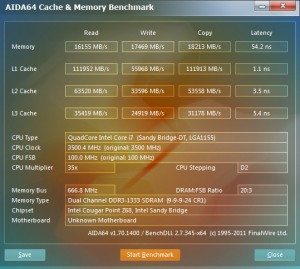
We managed to get a read speed of 16155 MB/s, a write speed of 17469 MB/s and a copy speed of 18213 MB/s. The latency for the memory at stock speed was 54.2 ns.
The next step for us was to see how far we could overclock, so we bumped the memory divider straight up to 1600MHz with stock timings and low and behold we managed to boot into Windows with 100% stability.
After toying with how far to go next, we attempted to move the memory divider again, but this time to 1866MHz. A failed boot occurred and we had to go back into BIOS to slacken off the timings a bit. We managed to loosen the timings to 9-10-9-28 whilst maintaining a 1T command rate and get a successful boot.
Knowing that the next step of 2133MHz was out of the question, we started to increase the BCLK instead, and whilst we’re aware that Sandy Bridge is quite restricting on the BCLK, we had a feeling that some extra juice could be squeezed out of these modules.
We started to ramp things up slowly until we hit a barrier at 106.0MHz which is fantastic considering how far we’d already pushed the modules by just using the memory divider.
We did find that the timings had to be slackened off a bit more to achieve this to 11-11-11-31 but as we’re using Sandy Bridge, it cares more for sheer performance opposed to latencies. We continued to boot and snapped a CPU-Z screenshot to confirm the correct settings at a successful 1979MHz from a stock 1333MHz. Simply WOW!
Now that we’d managed to push this memory to the limits, we wanted to see if it had made much of a difference within AIDA64. It surely did with some large increases across the board with a read speed of 20231 MB/s, write speed of 18520 MB/s and a copy speed of 22039 MB/s and the memory latency had dropped to 44.4 ns. These really were some great results, especially considering how easy it was to get to this speed.
We did find that the timings could be tightened up a little bit more but the stability wasn’t at 100% and would most likely require a voltage increase, but as we pushed our voltage to 1.65V anyway, we weren’t too keen on going past that, especially on a Sandy Bridge based system.
After looking at the EVO Corsa range of modules from GeIL a little while ago, we were quite clued up on their technology and what they could achieve but the Enhance Corsa surpassed all expectations and simply blew our ambitions out of the water.
The kit simply seemed like it didn’t want to stop from a stock 1333MHz with standard looking results to a whopping 1979MHz with extremely fast speeds, it simply left us with a massive smile on our faces.
Sadly there are no reputable retailers in the UK stocking this particular kit, but there are a few around that stock other similar kits including the 1600MHz kit that we’ll be looking at in the near future, so keep your eyes pealed if you’re after this exact set of modules.
I would normally sum things up with some kind of intelligent and somewhat witty comment, but I feel myself slightly lost for words as this kit has really done a great job in terms of performance and overclockability, and the fact they are bright orange really makes them stand out and that’s a good angle for GeIL to get them back into the market.
All I can say, is that I’m extremely excited to try out the 1600MHz dual channel kit as well as the quad channel kits that we have ready for Intel X79 very soon.

